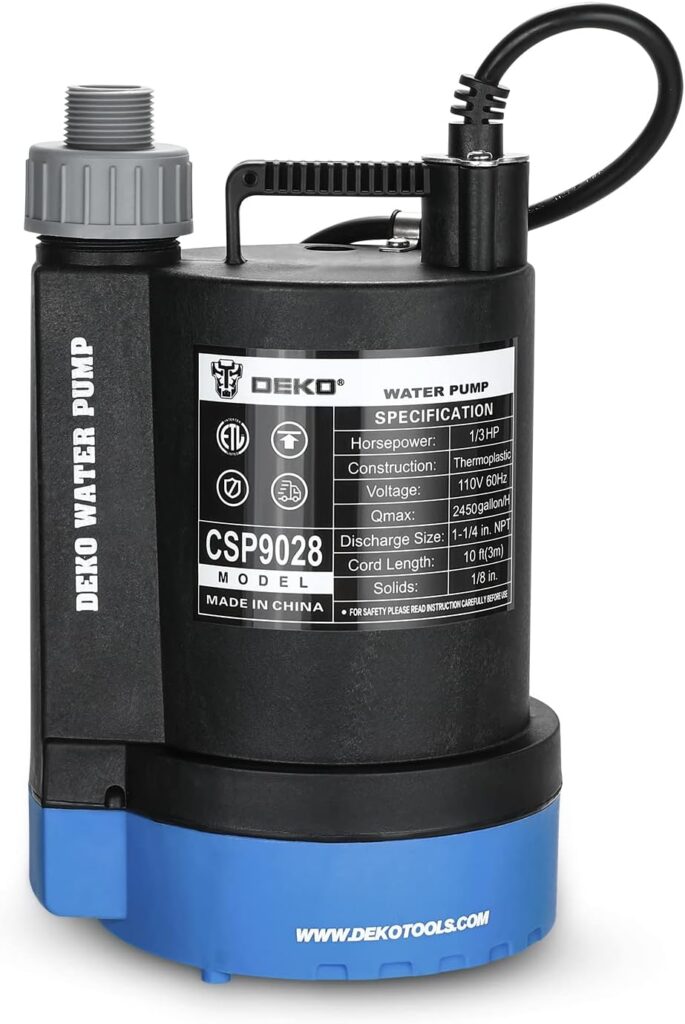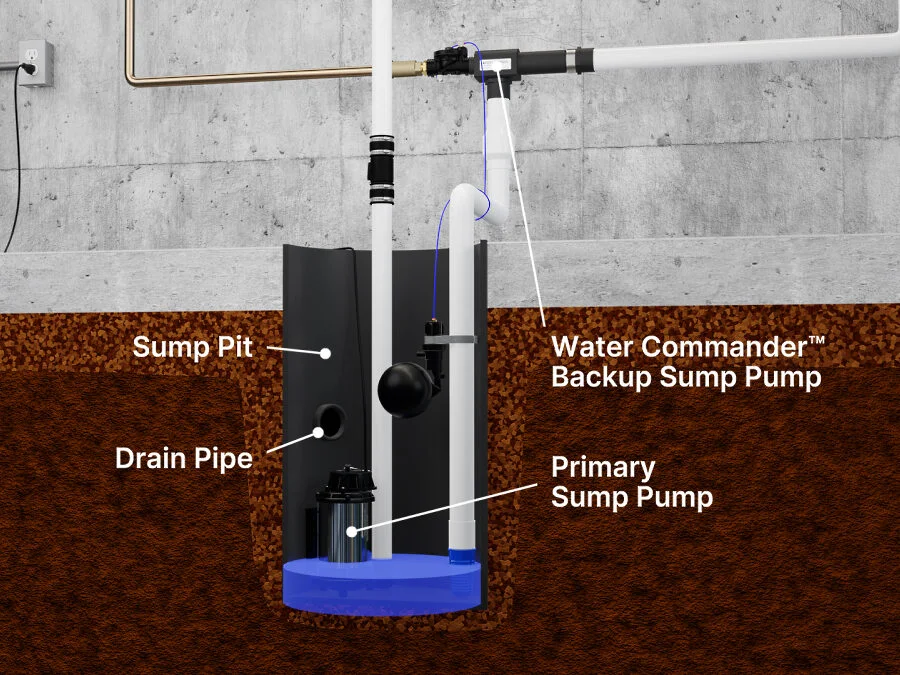Sump pumps are important for keeping basements and crawlspaces dry by pumping out excess water. The sump pump works by detecting rising water levels in the basin and automatically turning on to pump the water out through the discharge line, typically 10-20 feet away from the home, preventing basement flooding. They have a basin, pump, discharge line, and backup system.
Key Features of Sump Pumps made from Different Materials
When considering the optimal material for a sump pump, following are the choices
Cast Iron Sump Pumps:
Cast iron is generally considered the best material for sump pump construction, as it is more durable and corrosion-resistant compared to other options like thermoplastic or aluminum., Cast iron sump pumps are strong and can withstand tough conditions in a sump pit. They also dissipate heat better, which helps the motor stay cool and last longer. They have a lifespan of 15-20 years if maintained properly
Thermoplastic Sump Pumps:
Thermoplastic sump pumps are cheaper and easier to install than cast iron pumps. They are lighter but can get damaged easily and last 5-10 years. They may not be as durable or resistant to corrosion as cast iron pumps.
Stainless Steel Sump Pumps:
Stainless steel impellers are strong and resistant to rust. They can handle a lot of water flow. The motor housing is also made of stainless steel, which protects it well. While stainless steel is more costly than thermoplastic, it may be similar in price to cast iron.
Aluminum Sump Pumps:
Aluminum sump pumps are less expensive than cast iron or stainless steel pumps. They are strong and resist corrosion in sump pit systems. Some aluminum pumps have additional cooling with a special motor housing. They have aluminum impellers and internal parts. These pumps are typically 1/3 to 1/2 HP for homes. However, aluminum can still corrode more over time compared to cast iron or stainless steel.
Types of Sump Pumps
Submersible Sump Pumps
DEKOPRO Submersible Water Pump 1/3 HP 2450GPH Utility Pump Thermoplastic Electric Portable Transfer Water Pump with 10-Foot Cord for Pool Tub Garden Pond Draining (Amazon)

Submersible sump pumps are installed inside the sump basin and are designed to operate underwater.They have a waterproof motor and housing, allowing them to be fully submerged. Submersible pumps are generally more powerful and can handle more debris than pedestal pumps. They are also quieter and less prone to overheating
Pedestal Sump Pumps
Pedestal sump pumps have the motor mounted above the sump basin, with a shaft extending down into the water.The motor is not submerged, making pedestal pumps less expensive but also noisier and more prone to overheating. They work best in homes with minor flooding issues.
Superior Pump 92551 1/2 HP Cast Iron Pedestal Pump (Amazon)

Battery Backup Sump Pumps
Battery backup sump pumps are secondary pumps that automatically activate if the primary pump fails, often during a power outage.They are powered by a rechargeable battery and can provide hours of additional pumping capacity.
Combination Sump Pump Systems
Combination sump pump systems integrate a primary submersible pump with a battery backup pump in a single system, providing the highest level of flood protection. The best type of sump pump for a home depends on factors like the size of the sump basin, the expected water volume, power availability, and budget. Consulting a professional can help determine the most suitable sump pump setup.
You may also like: Your Gardening Experience with Premium Gardening Supplies
How to Install a Sump Pump?
Prepare the Site
First, you’ll need to choose a spot for the sump pump near a basement wall. Next, trace the sump liner’s outline on the floor. Take out the concrete floor and dig a hole deeper than the liner by 12 inches at least. Drop the liner into that hole. Around the sump liner’s sides, add gravel. Finally, pour new concrete over the floor.
Install the Pump
- Link the PVC pipes starting at the pump’s exit through the edge beam of the house
- Carefully set the pump inside the liner, then connect its power source
- Verify that the pump functions correctly prior to finishing the setup process
Attach Check Valve to Discharge Pipe
- Apply primer and cement the male-threaded adapter snugly onto the PVC pipe
- Apply primer, then cement the male adapter firmly onto the PVC pipe
- Wrench-tighten the adapter-end securely onto the pump
Drill the Weep Hole
- Tilt the pump at an angle, measure roughly two finger-widths above the adapter. Drill a 3/16″ hole at this point using a powered drill bit
- Angle-tilt the pump, eyeballing two finger-widths above the adapter
- Using a 3/16″ drill bit, create the weep hole at this point
Connect Drainage
- Ensure the sump pump drains to a designated area like a dry well, creek, or pond, at least 10 to 20 feet away from the foundation of your home
- Check local building codes for regulations on where the sump pump can drain
Installing a sump pump involves several key steps. You must carefully review the instructions that come with your specific pump model. In certain cases, seeking professional help may be wise for proper installation. These general guidelines give an overview, but consulting experts is crucial if needed.
Advantages and Disadvantages of Pedestal Sump Pumps
Pedestal sump pumps have benefits and drawbacks to consider.
Advantages
Cost-Effective: These pumps cost less to buy and install than submersible types.
Durable Construction: Pedestal pumps often last longer, making them a long-lasting option.
Ease of Maintenance: As they’re not submerged, servicing tends to be simpler and cheape.
Disadvantages
Lower Efficiency: They don’t pump water as quickly or efficiently as submersible models during heavy floods.
Space Requirements: Since above ground, these pumps need basement space, limiting use in compact areas and posing injury risks if improperly placed.
Excess Noise and Overheating: Pedestal pumps are noisier and likelier to overheat than submersible counterparts, causing potential nuisances and safety issues.
Homeowners should weigh these pros and cons against their specific needs when choosing between pedestal and submersible pumps.
FAQ’s
How often should a Sump Pump be Serviced?
Sump pumps need service based on pump type, how often they’re used, and surroundings. A pump underwater needs service every two years. One up high should get service every three years. But, check every three to four months for issues. And have it serviced once a year for an in-depth check. How often yours needs service depends on pump type, surroundings, and use. Ask a pro for advice on the right service schedule.
What are the signs that a sump pump needs repair?
If a sump pump ages, rusts, produces strange noises, functions erratically, or collects water in the basement, it has to be serviced. These indicators point to probable flooding difficulties, rust, uneven performance, water buildup, and mechanical faults. The pump may be made to work efficiently and possible flooding problems can be avoided with routine maintenance and quick attention to these indicators.
Disclosure: Some links on LucentZone.com may result in affiliate compensation if you choose to purchase a paid plan. Please refer to our privacy policy for our affiliate disclosure. Our site does not provide financial advice, it is for entertainment purposes only.

